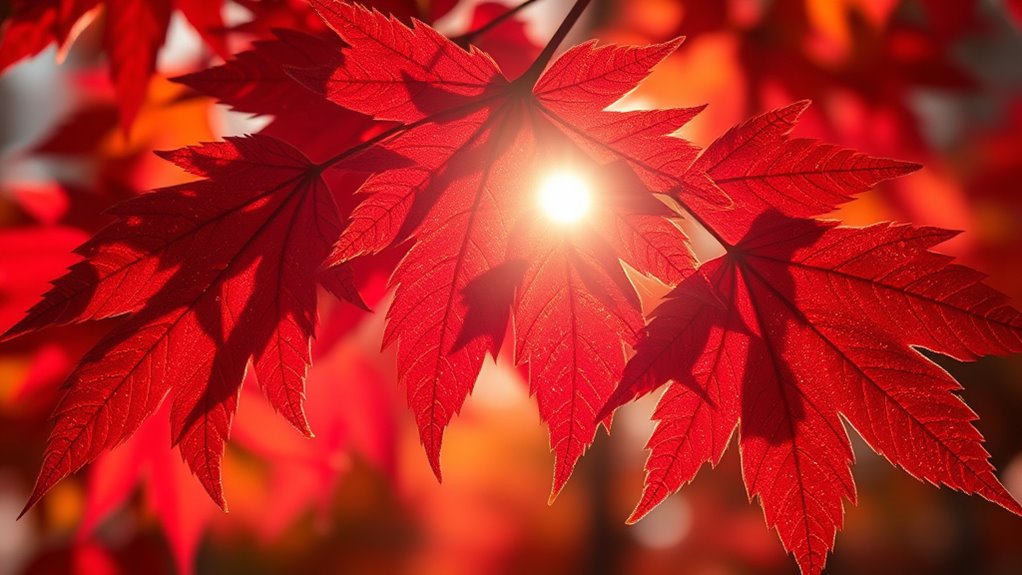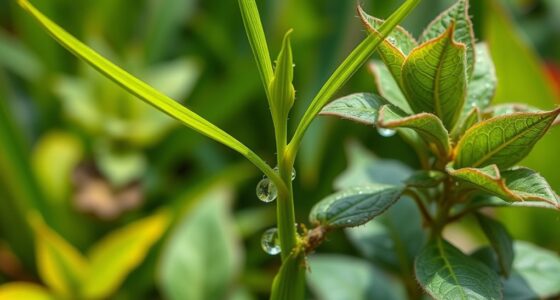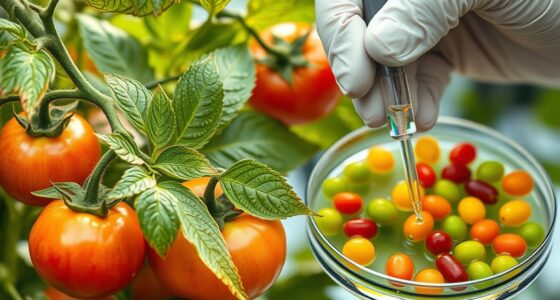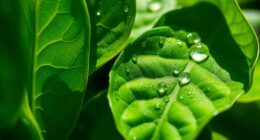When leaves turn red, your trees are producing anthocyanins to protect themselves from stress, like cold, drought, or nutrient shortages. These compounds act as natural sunscreens, shielding leaves from excess light and UV rays. The vibrant red color signals the tree’s defense mechanism, helping it conserve resources before shedding leaves for winter. To discover more about how trees use color to survive, keep exploring this fascinating process.
Key Takeaways
- Leaves turn red due to the production of anthocyanins, which become visible as chlorophyll breaks down in fall.
- Anthocyanins act as antioxidants, protecting leaf cells from damage caused by increased light and environmental stress.
- Stress factors like drought, cold, and nutrient deficiencies trigger the synthesis of anthocyanins as a defense mechanism.
- Sunny conditions enhance anthocyanin production, resulting in more vibrant red leaves during bright fall days.
- The red coloration helps regulate leaf temperature and shields tissues from UV damage, supporting the tree’s survival.

Have you ever wondered why leaves turn red in the fall? It’s a stunning transformation that signals the changing seasons, but behind this vivid display lies a fascinating process rooted in plant chemistry and survival strategies. When the days grow shorter and temperatures drop, deciduous trees prepare for winter by shutting down their food-making factories—photosynthesis. As chlorophyll, the green pigment responsible for capturing sunlight, breaks down, the underlying colors of the leaf become visible. One of these colors is red, produced by compounds called anthocyanins. These pigments are not just for show; they serve a vital purpose in helping the tree manage stress during this phase of change.
As chlorophyll fades, red anthocyanins emerge, protecting trees from stress and damage during fall’s changing season.
Anthocyanins are a type of antioxidant, meaning they help protect the leaf’s cells from damage caused by increased light exposure and oxidative stress. During fall, as chlorophyll diminishes, the leaf’s internal environment becomes more vulnerable. The sun’s UV rays can cause harm when the protective green pigment fades. By synthesizing anthocyanins, the tree creates a natural sunscreen, shielding its tissues from harmful radiation and preventing cellular damage. This process is especially important because, as the leaf’s nutrient supply dwindles, the tree needs to maximize its chances of reclaiming valuable resources before the leaf falls entirely. The red coloration acts as a defense mechanism, reducing the risk of damage and ensuring the tree’s energy reserves are preserved for the next season.
Moreover, the production of anthocyanins is often triggered by stress factors such as drought, cold temperatures, or nutrient deficiencies. These conditions signal the tree to bolster its defenses, and the intense red hues serve as a visual indicator of this heightened stress response. Interestingly, the amount of red visible on leaves varies depending on environmental conditions, with sunnier days intensifying the red colors. Sunlight encourages the production of anthocyanins, which is why you often see the most vibrant reds on trees with clear, bright days during peak fall. The red pigments also influence how the leaf interacts with light, helping to regulate temperature and protect delicate cells from excess sunlight.
In essence, the brilliant red of fall leaves isn’t just an aesthetic choice but a survival tactic. It’s a sign that the tree is actively defending itself against environmental stressors, optimizing its chances of recovery and growth in the following year. So, next time you admire those fiery reds, remember that they are a testament to nature’s ingenuity in protecting and preparing the tree for winter’s arrival.
Frequently Asked Questions
Do All Trees Turn Red in the Fall?
Not all trees turn red in the fall. Many species, like maples, showcase vibrant red leaves, while others, such as oaks and pines, display different colors or stay green. Your local climate and tree variety influence these changes. If you notice red hues, it’s often due to anthocyanins protecting the leaves from stress and sunlight. So, enjoy the colorful display, but don’t expect every tree to turn red.
Can Red Leaves Indicate Plant Health Issues?
Red leaves can sometimes indicate plant health issues, especially if they appear suddenly or in abnormal patterns. You should check for signs like wilting, spots, or unusual leaf drop, which might suggest pests, disease, or nutrient deficiencies. However, during autumn, red leaves are usually a natural part of the seasonal change. Keep an eye on overall plant robustness to determine if the redness is a normal process or a sign of trouble.
Are Anthocyanins Present Year-Round or Only in Fall?
Are anthocyanins present year-round or only in fall? You might think they’re just seasonal, but they actually linger in leaves all year, hiding in the cells until environmental triggers like stress or shorter days prompt their vibrant display. Like a hidden artist waiting for the perfect moment, plants produce anthocyanins continuously, but you only notice their red hues when conditions turn colder or brighter, revealing a secret palette that’s always there.
How Do Environmental Factors Influence Red Leaf Coloration?
Environmental factors like temperature, sunlight, and soil moisture directly influence red leaf coloration. When days are sunny and cool nights occur, your leaves produce more anthocyanins, turning red. Bright sunlight boosts pigment production, while drought stress can intensify coloration. Conversely, warmer or overcast conditions may result in less vibrant reds. By experiencing these conditions, your trees adapt and display striking red hues, showcasing nature’s response to environmental cues.
Can Humans Benefit From Anthocyanins in Plants?
Yes, you can benefit from anthocyanins in plants. These natural compounds act as antioxidants, helping to protect your cells from damage caused by free radicals. Consuming foods rich in anthocyanins, like berries, red grapes, and cherries, may boost your immune system, improve cardiovascular health, and reduce inflammation. Including these colorful fruits and vegetables in your diet can support overall well-being and potentially lower your risk of chronic diseases.
Conclusion
As the leaves blush with vibrant reds, they tell a story of resilience and transformation. You can think of anthocyanins as nature’s fiery armor, protecting and dazzling as the seasons shift. Just like a painter adding bold strokes to a canvas, trees turn red to defend themselves and prepare for change. So next fall, marvel at the fiery spectacle — it’s nature’s way of showing strength and beauty in every leaf’s final act.










